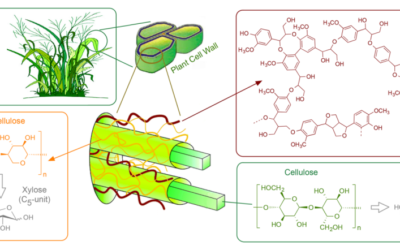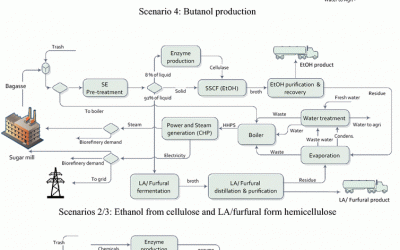
Oldest Biorefineries used for Pretreatment of Lignocellulose: The Cows
Levulinic acid is a platform chemical with significant potential to substitute petroleum-based products in the chemical and fuel sectors.
Agricultural waste, cow dung, was used as feedstock for the production of a high value–added chemical levulinic acid (LA) in dilute acid aqueous solutions [1].
DalinYebo Commentary:
- Historically, cow dung’s value was seen in the inorganic matter (as fertiliser).
- Globally, enormous quantities are produced (2016 estimated at >3 billion tpa [2])
- Cow dung has a high (±75-85%) organic component consisting mainly of lignocellulose. Traditionally, farmers have been composting it prior to spreading it onto their fields.
- In recent years, cow dung has been used as feed to anaerobic digesters for the production of ‘bio-gas’ (for conversion to e.g. LPG or electricity).
- As demonstrated in this article, the lignocellulosic matter is an untapped ‘partially pre-treated’ feed for bio-based chemicals. It contains -monosaccharids such as glucose, galactose, arabinose, manose and xylose.
- Literature suggests the xylose content to be in the order of 15 – 20% on dry manure and ..
.. we suggest: Make Furfural!
Tag: µ-BioRefinery | Search: Biomass | Explore: Map to Furfural and its many By-products
DalinYebo: Bioeconomy Consultants
Technology . Markets . Knowhow
NB: The article below is posted ‘as is’, i.e. it has not been validated nor is its re-blogging an endorsement by DalinYebo
Researchers from “Agro-Environmental Protection Institute, Chinese Academy of Agricultural Sciences” developed a promising strategy for the value-increment utilization of cow dung.
A high LA yield of 338.9 g/kg was obtained from the pretreated cow dung, which was much higher than that obtained from the crude cow dung (135 g/kg), mainly attributed to the breakage of the lignin fraction in the lignocellulose structure of the cow dung by potassium hydroxide (KOH) pretreatment, and thus enhanced the accessibility of cow dung to the acid sites in the catalytic reaction.
Meanwhile, another value-added chemical formic acid could be obtained with a yield of ca. 160 g/kg in the process, implying a total production of ca. 500 g/kg yield for LA and formic acid from the pretreated cow dung with the proposed process. The developed process was shown to be tolerant to high initial substrate loading with a satisfied LA yield. This work provides a promising strategy for the value-increment utilization of lignocellulosic agricultural residues.





